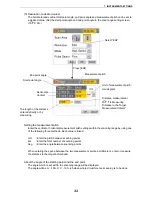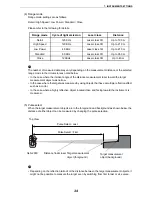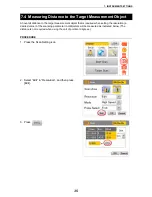
47
8. FLOW OF THE CONFIGURATION SCREEN
Import the coordinate point file
The coordinate point name and the coordinate value described in CSV file format can be imported into the
instrument via the SD card. The occupied point name and the occupied point coordinate or the backsight
point name and the backsight point coordinate can be selected from the imported coordinate list.
The imported coordinate list is retained even after turning OFF the instrument.
Conditions to create the CSV file (coordinate point file)
Create the CSV file in accordance with the following conditions.
Example of creating a CSV file
1. Enter the name of the coordinate point and E, N, and H (X, Y, and Z) in a text file.
2. Change the extension to CSV or enter the name of the coordinate point and E, N, and H
(X, Y, and Z) in a file such as Microsoft Excel's.
3. Change the format of the file to CSV when saving it.
8.9 Handling the Coordinate Point File
Items
Conditions for creation
CSV file
A CSV file is comma delimited, and records fields in the following order:
coordinate point name, E, N, H (X, Y, Z).
Example
pt-01,1105.494,1069.231,6.6,
pt-02,1110.989,1088.461,7.2,
pt-03,1116.483,1107.691,7.8,
Save the CSV file in the highest hierarchy in the SD card. If the file is saved in
any lower hierarchy, it cannot be imported.
Up to 250 coordinate points can be imported. (Up to 250 coordinate points are
registered.)
They are read with the coordinate system.
Always use “***.csv” for the file extension. (Case insensitive)
Point name
Use up to eight characters for the coordinate point name. (For a long string, up
to eight characters are automatically imported, and the ninth and subsequent
characters cannot be imported. As a consequence, multiple identical coordinate
point names may exist.)
Coordinate
value
Express the coordinate value within the range of ±99999999.999 m.
(A coordinate value that exceeds the range cannot be imported.)
















































